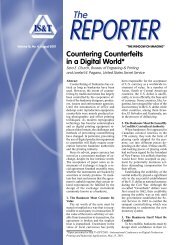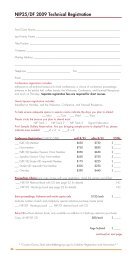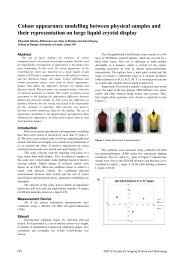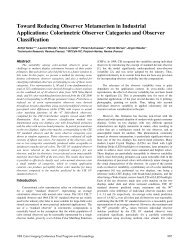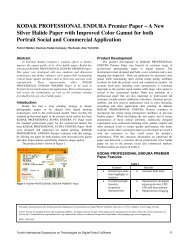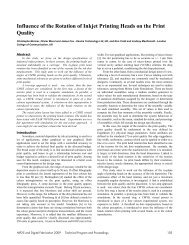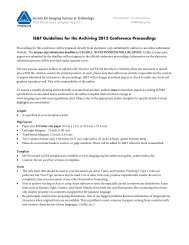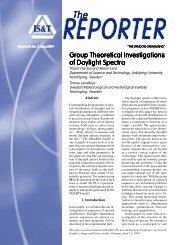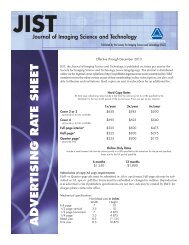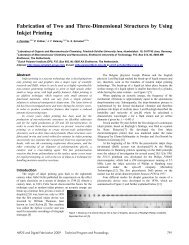JIST - Society for Imaging Science and Technology
JIST - Society for Imaging Science and Technology
JIST - Society for Imaging Science and Technology
You also want an ePaper? Increase the reach of your titles
YUMPU automatically turns print PDFs into web optimized ePapers that Google loves.
Journal of <strong>Imaging</strong> <strong>Science</strong> <strong>and</strong> <strong>Technology</strong>® 51(5): 424–430, 2007.<br />
© <strong>Society</strong> <strong>for</strong> <strong>Imaging</strong> <strong>Science</strong> <strong>and</strong> <strong>Technology</strong> 2007<br />
Relationship between Paper Properties <strong>and</strong> Fuser Oil<br />
Uptake in a High-speed Digital Xerographic Printing<br />
Fuser<br />
Patricia Lai <strong>and</strong> Ning Yan <br />
University of Toronto, 33 Willcocks Street, Toronto, Ontario M5S 3B3, Canada<br />
E-mail: ning.yan@utoronto.ca<br />
Gordon Sisler<br />
Xerox Research Center of Canada, 2660 Speakman Drive, Mississauga, Ontario L5K 2L1, Canada<br />
Jay Song<br />
Cincinnati <strong>Technology</strong> Center, International Paper Company, 6283 Tri-Ridge Blvd,<br />
Lovel<strong>and</strong>, Ohio 45140-8318<br />
Abstract. The fuser roll in high-speed xerographic printers is typically<br />
coated with a silicon-based oil to facilitate clean splitting of the<br />
fused image <strong>and</strong> paper as it exits the fusing nip. If oil uptake by<br />
paper is excessive, the fuser roll will become insufficiently coated<br />
with oil. Consequently, both image quality <strong>and</strong> fuser roll life will be<br />
negatively impacted. A variety of commercial papers were characterized<br />
<strong>and</strong> evaluated <strong>for</strong> their oil uptake per<strong>for</strong>mance. Using partial<br />
least-squares regression, key paper properties correlated with oil<br />
uptake were identified. Surface energy of paper was found to have<br />
the strongest correlation with oil uptake. Furthermore, based on<br />
contact mechanic theories, a contact area index (CI) was used to<br />
describe the degree of contact between paper <strong>and</strong> the fuser roll at<br />
the nip. A positive correlation between oil uptake <strong>and</strong> CI suggests<br />
that roughness <strong>and</strong> stiffness also have significant influences on oil<br />
uptake. © 2007 <strong>Society</strong> <strong>for</strong> <strong>Imaging</strong> <strong>Science</strong> <strong>and</strong> <strong>Technology</strong>.<br />
DOI: 10.2352/J.<strong>Imaging</strong>Sci.Technol.200751:5424<br />
INTRODUCTION<br />
High-speed digital xerographic printing presses are versatile<br />
with the capability to produce high resolution prints on a<br />
variety of media at rapid speeds. The focus of this study is<br />
on the fusing section, where the image is fixed onto paper.<br />
Hot roll fusing is the most common fixing method <strong>for</strong> these<br />
printers, where toner is fused onto the substrate by heat <strong>and</strong><br />
pressure within a nip <strong>for</strong>med by two rotating rolls, which are<br />
typically a fuser roll <strong>and</strong> a pressure roll 1 (Figure 1).<br />
Clean splitting between the fuser roll <strong>and</strong> paper with a<br />
toner image must be achieved to produce a sharp image<br />
without offset at high reproduction speeds. To facilitate this,<br />
the fuser roll is typically lubricated with a release agent, in<br />
most cases a silicon-based oil, that is applied continuously<br />
using a donor roll. The printing media takes away oil at the<br />
fusing nip <strong>and</strong> over time, with high volume production, excessive<br />
oil uptake may occur, resulting in oil depletion within<br />
the system. Consequently, the fuser roll will become insufficiently<br />
coated, resulting in toner offset, poor print quality,<br />
<strong>and</strong> a reduction in fuser roll life.<br />
Over the years, extensive research in the area of fusing in<br />
xerographic printing has focused on the interaction between<br />
toner <strong>and</strong> paper in terms of the effect of paper properties,<br />
toner properties, <strong>and</strong> operational conditions on fusing fix. 2–4<br />
However, an important aspect in the fusing process that has<br />
not been well studied is the effect of fuser roll lubrication on<br />
print quality. It has been observed that the oil depletion rate<br />
varies with different types of papers in high-speed xerographic<br />
printing, but thus far the specific paper properties<br />
that control this oil depletion rate are not clear.<br />
This study aims to bridge this gap in the literature by<br />
identifying the key paper properties that control fuser oil<br />
uptake <strong>and</strong> by obtaining a mechanistic underst<strong>and</strong>ing of the<br />
interactions between oil, paper, <strong>and</strong> the fuser roll material.<br />
An underst<strong>and</strong>ing of the interactions between fuser oil <strong>and</strong><br />
paper is of fundamental importance in improving fuser roll<br />
life <strong>and</strong> print quality. Meanwhile, underst<strong>and</strong>ing these interactions<br />
will help papermakers optimize paper properties to<br />
minimize fuser oil consumption <strong>and</strong> eliminate downstream<br />
problems, such as oil streaks on the printed copy.<br />
<br />
IS&T Member.<br />
Received Jan. 22, 2007; accepted <strong>for</strong> publication May 10, 2007.<br />
1062-3701/2007/515/424/7/$20.00.<br />
Figure 1. Schematic of the fusing section in a high-speed xerographic<br />
printing press.<br />
424




